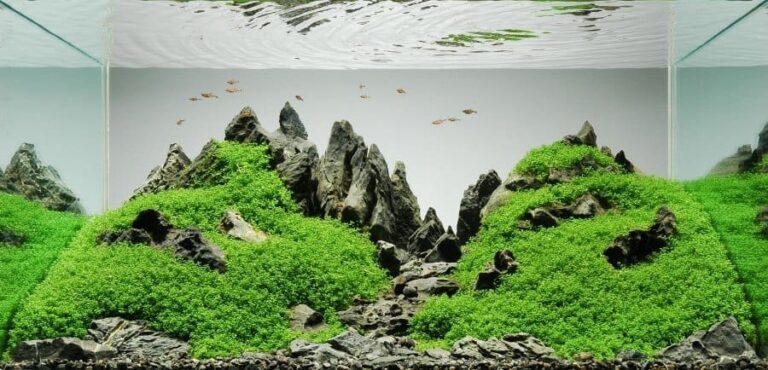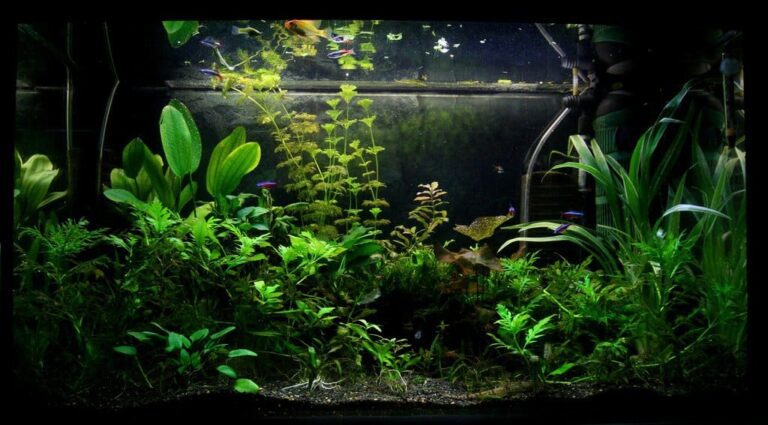Naturally, whenever we think of aquariums- we imagine tons of water, vibrant colored fish, some UV lights, and a whole bunch of plants. But those with a vivacious taste want something unseen in mundane life. For them, a sand aquarium is a perfect match.
Plants in a sand aquarium pave the way for a unique visual appeal. You can choose low-maintenance plants like java moss and anubias, or you can add something more exotic but delicate like Madagascar lace for your sand aquarium.
In this article, you’ll find all the info that is important to know before choosing the best plants for sand aquariums. So, without any further ado, scroll down for more.
Challenges of Growing Plants in A Sand Aquarium
So it is obvious that you may want a sand aquarium for aesthetic purpose. But the fact is, sand is an inert substrate. And it contains zero nutritional value. On the other hand, plants, be it aquatic or terrestrial, require nutrients for their life.
In the planted tank hobby we usually use commercial aquasoil for plants as they are rich with nutrients. If you want to use sand as a substrate then you need to overcome this challenge. There are two ways to overcome –
- Use commercial aquasoil in the bottom layer and cap it with sand so that it is not visible. In this process you can actually grow any aquatic plants you want, provided that all the requirements are met. But then it becomes a costly solution!
- Or, you can choose your plants carefully with certain properties. Some aquatic plants don’t depend on the substrates for their nutritional needs. They collect necessary trace elements from the water column. All you need to ensure is regular fertilizer dosing, adequate CO2 supply and good light.
Lets know about 12 such amazing plants that can be grown in a sand aquarium.
12 Best Plants For Sand Aquarium
Sand is not really the best living condition for a plant. There are only a handful of plants that can thrive in such places. I handpicked some aquatic plants that I think are the best ones for sand aquariums. I’ll highly suggest you pick one of these if you’re starting out-
Anubias
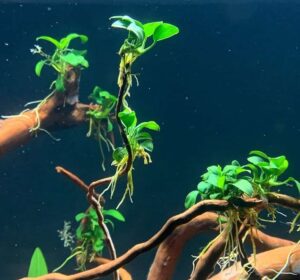
Anubias is one of the best plants for sand aquariums. This plant is basically a rhizome plant that does not go inside the sand. In fact, this plant does not require burying the roots. Also, this plant can easily survive being attached to rocks, driftwood, or decorative.
Anubias barteri var. barteri and anubias nana are the two kinds of mostly used plants in sand aquariums. Anubias is a heart-shaped plant. Barteri grows up to 35 cm, and nana is a dwarf plant, grows only up to 5 cm. Both have a pH level of 5.5-9.0.
Anubias barteri is generally positioned in the back, and anubias nana is positioned in the front. Anubias nana (one leaf every month) is comparatively faster than anubias barteri (one leaf every three months).
Lemon Bacopa

If you are looking for a hardy plant that grows and spreads fast and suits any kind of soil, including sand, then Lemon Bacopa is the one for you. It is a compact delicacy to the aquarists. The plant only grows up to 2 inches, which makes it really cute to look at.
Lemon Bacopa not only looks good, but it is also useful for the inhabitants of the aquarium as well. The plant provides shelter for the fish- to hide and to reproduce. Additionally, this plant also works as a natural filtration.
It is a plant that grows fine in any kind of substrate and without any fertilization. But, for better growth, I’d recommend that you use root tabs and a water column. Lemon Bacopa has a pH tolerance level between 6-7.5 and a temperature tolerance between 68-82 Fahrenheit.
A fair amount of lighting is necessary for it to grow in its full glory. You need to make sure the plant is not overshadowed by any floating ones, though low light won’t hold it back from growing.
Amazon Sword
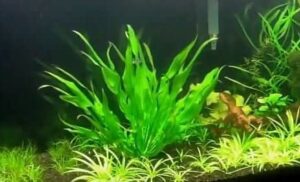
Another popular plant for sand aquariums is the Amazon sword. This plant is perfect for sand substrate and easy to grow. Amazon swords can grow up to 16 inches and tolerate temperature as low as 60-degree Fahrenheit, making them a hardy plant.
If you want your Amazon Sword to grow to its fullness, place it in a bright area as this plant requires a decent amount of sunlight for at least 11-12 hours a day.
Amazon sword has a pH level of 6.5-7.5 and can be placed in the background. Also, it’s better if the layer of the substrate is 2.5 inches thick. You can use liquid fertilizers if you want, but that is unnecessary for a tough plant like an amazon sword.
Java Moss

Java moss is a pretty familiar name to the aquarium keepers. This plant is famous for its slow growth, low- maintenance nature, and high tolerance. It is a fantastic plant that can tolerate any temperature between 68-82 degrees Fahrenheit and can grow even in low lighting.
Java Moss is the kind that floats as it doesn’t have any true roots. So, to keep it in place, you need to weigh it down. It doesn’t matter if the water is salty. Java Moss can tolerate pH level 6.0- 7.5 and water salinity up to 1.009. It grows up to 13.5 inches tall and 6-8 inches wide. This plant is also useful for the breeding of certain types of fish.
If you really want to care for it, place it near the pump to get some water movement and trim it now and then.
Dwarf Lily

If you want to make your sand aquarium appear attractive, you must have Dwarf Lily in your aquarium. The only thing you need to worry about this plant is the plant’s bulb because if the bulb is covered in the substrate, roots will rot, and the plant will die eventually. Bury only 1/3 of the bulb of the plant just enough to anchor.
Dwarf lily requires a long period of light. Also, to keep it healthy, you might want to use some fertilizer. With fertilizer and sunlight, Dwarf Lily will do pretty well in the sand aquarium.
Dwarf Lily has the pH tolerance level of 5.5-7.5 and can stand temperature between 72-82 degrees Fahrenheit. With the right water parameter, the plant surely will make your sand aquarium stand out.
Anacharis
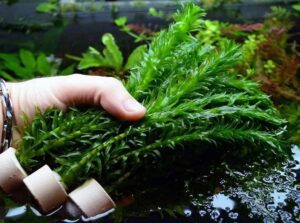
Anacharis is a multipurpose plant and an excellent option for beginners. This plant can be considered as a never-ending green for your long-cherished aquarium. Anacharis is great to be used as a background plant- you can place it anywhere you choose.
This plant doesn’t really need any special care. The only thing you need to think about is the plant taking over your aquarium. This plant grows super quick in any water condition but needs a moderate quantity of sunlight.
The pH tolerance of Anacharis is 6.5-7.5 and can survive in a temperature between 60-82 degrees Fahrenheit.
This plant is not only appealing to the eye but also beneficial for the aquarium inhabitants. Anacharis absorbs all the extra nutrients from the water, which prevents algae from growing. It also acts as a natural filter for the aquarium.
Java fern

Another popular choice for aquarium plants is java fern. It is another low-maintenance plant that does not require much care and sunlight. In fact, too much sunlight can turn this plant brownish and transparent.
Though it does well without sunlight, java fern still needs nutrients. You can add some liquid fertilizer for this particular type of plant. Plus, make sure you do not bury the roots. Instead, attach the plant to a piece of wood or rocks.
This plant has the ability to tolerate any water variable. This plant’s ideal temperature is 68-82 degrees Fahrenheit, and its pH tolerance is 6-7. Java fern is a slow-growth plant, so you need not worry about it taking over the aquarium. But as it can grow up to 13.5 inches, so, better to place it in the middle or at the back of your tank.
Java fern not only looks good, but it also provides protection to the fish inside the tank.
Cabomba

Cabomba is a popular aquarium plant. Though it is not a beginner’s plant, it is also not hard to keep. This plant is easy to grow if there is enough sunlight and CO2 in the water.
Cabomba is a very delicate plant. Fishes and apple snails tend to eat them, so not ideal for an aquarium full of fish.
The plant’s standard pH tolerance is 6.8-7.5, but some also suggest that lower is better. Cabomba can survive in 72-82 degrees Fahrenheit water temperature. The plant grows well in clean and stable water. If the surrounding water moves too quickly, this delicacy may be uprooted and die.
Cryptocoryne
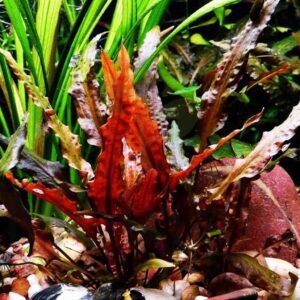
Another perfect plant for aquarium lovers is cryptocoryne. This slow-growth plant is of many shapes and sizes. They are ideal for sand aquariums and easy to keep. This plant doesn’t need much light to grow, so the CO2 consumption level is low. Also, it is a pretty good option to keep in the background.
Cryptocoryne only grows up to 6 inches, and the leaves grow up to 18 inches. They are of different colors, which makes them popular among aquarists. Like Cabomba, this plant also needs stable water conditions. It has a pH tolerance level of 6.0-8.0 and can grow in 72-82 degrees Fahrenheit.
This plant is generally placed as a background.
Ludwigia repens

For its vibrant color and hardiness, Ludwigia repens is very popular among aquarium enthusiasts. It is another low maintenance aquatic plant, which identifies it as a beginner-friendly plant to keep.
This plant can tolerate pH levels between 5 to 8 and temperature between 60-80 degrees Fahrenheit. Ludwigia repens requires moderate to high light.
This plant is not small in size. They can grow up to 19 inches in a preferable environment. So, it is better to place it at the back. There is no need to add extra fertilizer as it is a very hardy plant and can survive in any water.
Rotala Indica
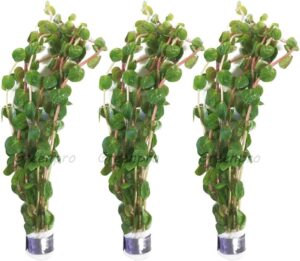
Just like Ludwigia, Rotala Indica is perfect for a sand aquarium. It is colorful, low maintenance, and fast-growing. For its beauty and fast growth, Rotala Indica is considered a classic aquatic plant.
The only thing that you need to take care of this plant is that it grows fast. The color of the plant changes depending on the sunlight it gets. When the light level is increased, the plant turns pinkish, and when it gets closer to light, the plant turns bright red. If you want the plant colorful, make sure to withhold nitrogen.
Rotala indica has a pH tolerance level of 6.5-7.5 and can endure water temperature from 72 degrees to 82 degrees Fahrenheit. The plan can grow up to 14 inches. So, if you want to keep it short, you need to trim it. The best part of pruning Rotala Indica is, you can grow another plant from the cut piece.
This plant works super well in oxygenating the aquarium water.
Madagascar Lace

This unique-looking plant will enhance the charm of your aquarium. While it is a high maintenance plant, its elegance makes it worth all the effort.
I am addressing this plant as difficult because Madagascar Lace needs specified water conditions and light. The water should be clean and free from algae or any debris. This plant grows alright in the sand but needs fertilizer to keep it healthy. My suggestion for this delicate plant would be to use fertilizer rich in iron and trace elements.
Madagascar Lace grows up to 25 inches. It requires moderate to high sunlight and CO2 for proper growth. This plant has a pH tolerance level of 6-7 and can take 72-82 degrees Fahrenheit. If taken care of properly, Madagascar lace will give you flowers as beautiful as its lace-like leaves.
How to take care of plants in a sand aquarium ?
Planting greens in a sand bed needs constant care and the right condition to grow. They might not survive if not given proper care. The plants provide environmental benefits to the aquarium and its habitats. So, it is kind of an important thing to deal with. I’ll be providing you with some tips and tricks to keep them healthy and comfy.
1. Choosing the right plants
Choose the plants that require fewer conditions and fit just right in your aquarium. You can pick from the suggestion I’ve given, or you can choose plants of your own choice. But make sure to check each plant’s compatibility with the water condition and habitats if there is any.
2. Install Good Lights
Plants need light, and they need it for a minimum period of time. Most plants need a minimum of 10-12 hours of light. Install aquarium light to your aquarium for the comfort of both plants and fish.
3. Fertilizer Dosing
Fertilizing the substrate is another way of pampering your aquarium plants. Plants need nutrients to grow to their fullest. Insert root tabs in the substrate or apply liquid fertilizer in the water.
4. Tidy up the plants
Trimming your plant is a vital task to keep them healthy and hearty. Though there are plants that don’t need pruning, some grow fast and tall. If they are not trimmed in time, the plants may take over the aquarium and block essential light, thus risking other plants’ life. So, it is crucial to trim and remove dead and decaying plant parts.
5. Keeping the water clean
The last and the most crucial concern is to keep the water clean. Like any other living thing, plants too require clean surroundings. You must clean the aquarium regularly. If the water is polluted and dirty, the plants and the fish (if there is any) will be affected.
While cleaning the tank, keep a close eye on the pH level of the water. Most plants have a pH level of 6.5 to 7.8. make sure to maintain the level after you clean the tank and change the water.
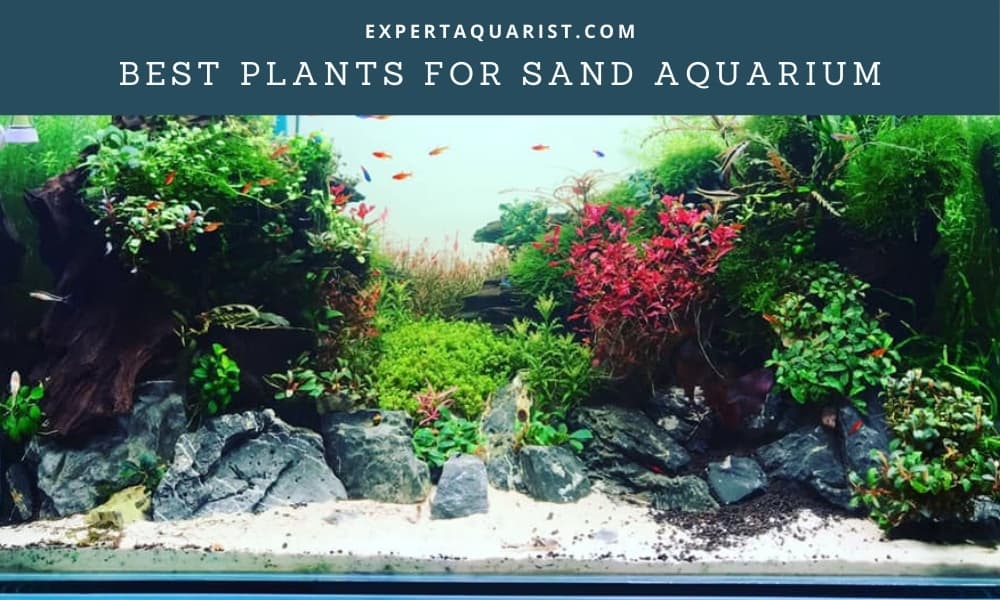
What kind of sand is the best for aquatic plants?
There are a lot of choices while choosing the best kind of sand for your aquatic plant garden. Looking for a cheaper but effective and beneficial option among many can be tough. I am here to make things a bit easier for you.
If you want an inexpensive and low-key option, then you can consider using play sand. It is cheap, comes in a range of grain sizes and colors, and available everywhere. Play sand is a safe game to play but clean it properly to avoid issues for your fish and plants.
Silica sand is another option for you to choose- not the cheapest, but pocket-friendly and offers various colors and grain size range. It is mainly used in swimming pools, but aquariums will do too. The best thing about it is that you can customize the sand any way you like!
Specialized aquarium sand is not the cheaper option but one of the best ones. They are specially produced to be used in aquariums. This type of sand can be easily found in any pet stores or big box stores.
The last but not the least option is live sand. Live sand is wet and is home to beneficial bacteria that are extremely useful for improving aquariums. This type of sand prevents harmful bacteria from building up and helps the plants stay healthy.
But rather than using only one type of sand, I’d suggest mixing and match several for better results.
Is sand substrate good for aquarium plants?
The whole write-up is about the plants which are the best options for sand aquariums. But can sand be considered to be a suitable substrate for aquariums? In most cases, gravel is the most popular choice. But sand is not far behind.
As an inexpensive and easily found substrate, I think using sand is the best possible alternative for aquariums. Let’s see why-
Versatile Substrate
Using sand in aquariums is not only money-saving; it has many advantages too. Sand is a very capable substrate to keep the plants secure. If you want your carpeting plant to flourish, choose sand over gravel. Because gravels usually prevent the growth of carpeting plants, while it is more comfortable in sand.
Gentle to the delicate plants
Aquatic plants have soft and delicate roots in general. Some plants even die if their roots are under the substrate. Sand gives plants the right amount of weight to firmly establish themselves without damaging the roots or stems.
Drawbacks of using sand for aquatic plants
Like everything else, sand too has some downfalls. As the sand bed gets older, the grain space reduces and can get tighter around the plants’ roots. Also, it can create problems while implanting new plants into the old sand bed. This can result in the decay of the existing plants.
Plus, a sand bed needs a minimum depth to bear any plant. The minimum thickness of the sand bed should be around 2.5 cm/ 1”. The consistency should not exceed 3 inches because more than that may cause anoxic pockets to build up.
Make your aquarium attractive!
Who doesn’t love to see beautiful colors in their treasured aquariums? I know I do. Plants are an affordable way to change the outlook of your aquarium exponentially. Especially for a sand aquarium, they provide a stark and attractive contrast.
And I hope this article will be the help you need in choosing the best plants for sand aquarium. Therefore, pick the plant that matches your liking and decorate your aquarium as you like. Be the aquarist you’ve been dreaming of.

